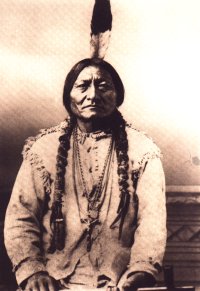

Sitting Bull was a Hunkpapa Lakota chief and holy man under whom Lakota tribes united in their struggle for survival on the northern plains. He remained defiant toward American military power and contemptuous of American promises to the end.
He was born around 1831 on the Grand River in present day South Dakota, at a place the Lakota called "Many Caches," for the number of food storage pits they had dug there. Sitting Bull was given the name "Tatanka-Iyotanka," which describes a buffalo bull sitting intractably on its haunches. It was a name he would live up to throughout his life.
As a young man, Sitting Bull became a leader of the Strong Heart warrior society and (later) a distinguished member of the Silent Eaters, a group concerned with tribal welfare. He first went to battle at age 14, in a raid on the Crow, and saw his first encounter with American soldiers in June, 1863, when the army mounted a broad campaign in retaliation for the Santee Rebellion in Minnesota, in which Sitting Bull's people played no part. The next year, Sitting Bull fought US troops again, at the Battle of Killdeer Mountain. In 1865, he led a siege against the newly established Fort Rice in present day North Dakota. Widely respected for his bravery and insight, he became head chief of the Lakota nation about 1868.
Sitting Bull's courage was legendary. Once, in 1872, during a battle with soldiers protecting railroad workers on the Yellowstone River, Sitting Bull led four other warriors out between the lines, sat calmly sharing a pipe with them as bullets buzzed around, carefully reamed the pipe out when they were finished, and then casually walked away.
In March, 1876, three columns of federal troops under General George Crook, General Alfred Terry, and Colonel John Gibbon moved into their area. Sitting Bull summoned the Lakota, Cheyenne, and Arapaho to his camp on Rosebud Creek in Montana Territory. There he led them in the sun dance ritual, offering prayers to Wakan Tanka, their Great Spirit, and slashing his arms one hundred times as a sign of sacrifice. During this ceremony, Sitting Bull had a vision in which he saw soldiers falling into the Lakota camp like grasshoppers falling from the sky.
Inspired by this vision, the Oglala Lakota war chief (Crazy Horse) set out for battle with a band of 500 warriors, and on June 17, surprised Crook's troops and forced them to retreat at the Battle of the Rosebud. To celebrate this victory, the Lakota moved their camp to the valley of the Little Bighorn River, where they were joined by 3,000 more Indians who had left the reservations to follow Sitting Bull. Here they were attacked on June 25 by the Seventh Cavalry under George Armstrong Custer, whose badly outnumbered troops first rushed the encampment as if in fulfillment of Sitting Bull's vision, and then made a stand on a nearby ridge where they were destroyed.
In May 1877, he led his people across the border into Canada, beyond the reach of the US Army. Four years later, however, finding it impossible to feed his people in a world where the buffalo was almost extinct, Sitting Bull finally came south to surrender. On July 19, 1881, he had his young son hand his rifle to the commanding officer of Fort Buford in Minnesota explaining that in this way he hoped to teach the boy "that he has become a friend of the Americans." However, he also told them, "I wish it to be remembered that I was the last man of my tribe to surrender my rifle." They were sent to Standing Rock reservation initially, but there was a fear that he might inspire another uprising. So, they were sent further down the Missouri River to Fort Randall, where he and his followers were held for nearly two years as prisoners of war.
In 1883, he was allowed to rejoin his tribe at Standing Rock. In 1885, he was allowed to leave the reservation to join Buffalo Bill's Wild West, where he earned $50 a week for riding once around the arena. He stayed with the show only four months, unable to tolerate white society any longer. Returning to Standing Rock, Sitting Bull lived in a cabin on the Grand River, near where he was born. He refused to give up his old ways as the reservation's rules required (he still lived with his two wives).
After his return, he had another vision. This time he saw a meadowlark alight on a hillock beside him, and heard it say, "Your own people, Lakota's, will kill you." Nearly five years later, this vision also proved true.
At Standing Rock, the authorities feared that Sitting Bull (still revered as a spiritual leader) would join the Ghost Dancers. They sent 43 Lakota policemen to bring him in. Before dawn on December 5, 1890, the policemen burst into Sitting Bull's cabin and dragged him outside where his followers were gathering to protect him. In the gunfight that followed, one of the Lakota policemen put a bullet through Sitting Bull's head.
